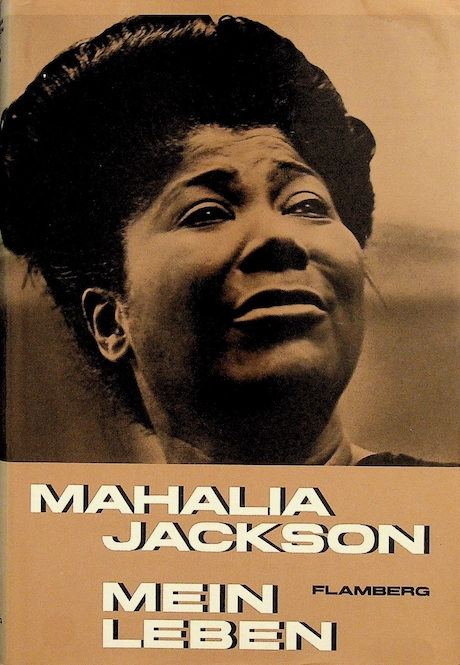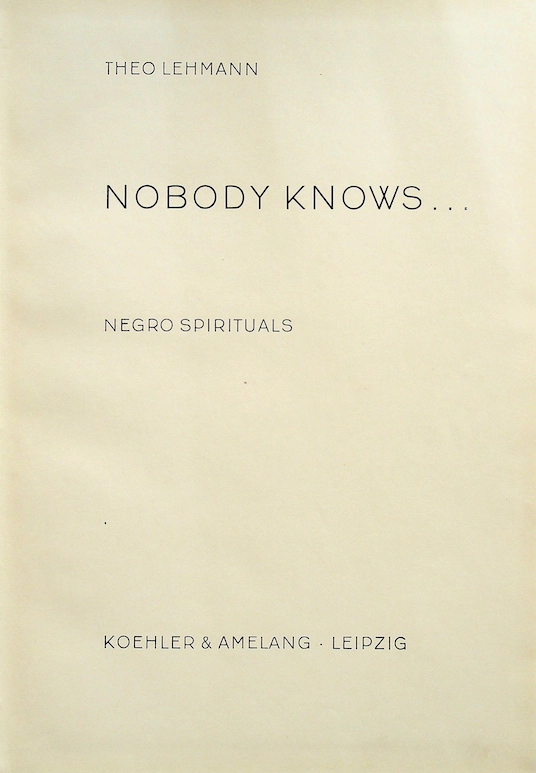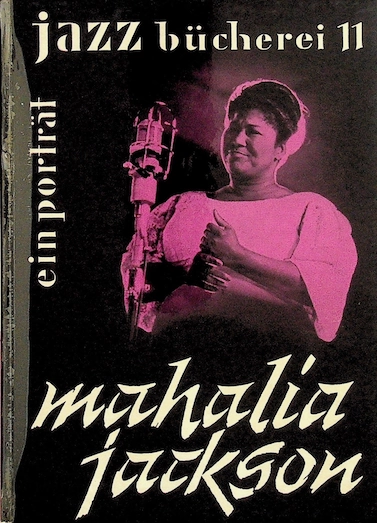
Mahalia Jackson - Mein Leben
Flamberg Verlag (Zwingli Verlag, Zürich) 1969
This edition is the German translation of the autobiography "Movin' On Up," which Mahalia Jackson wrote in 1966 together with Evan McLeod Wylie. The book was intended to capture Mahalia's life story and her personal perspective on her career. Although "Movin' On Up" was intended to be Mahalia's authentic narrative, as stated in the original edition, it is questionable whether this was actually achieved. There are indications that Mahalia expressed frustration with Wylie's "misrepresentations" of her oral accounts and the presence of misinformation. This suggests potential inaccuracies or interpretations of her words by the co-author that did not fully match Mahalia's own recollections. Nevertheless, the book offers intimate insights into Mahalia Jackson's life that are, in a sense, first-hand and is the first "Mahalia book" ever published.
This edition is a large-format hardcover.

Mahalia Jackson - Mein Leben
Evangelische Verlagsanstalt 1974
This edition is the German translation of the autobiography "Movin' On Up," which Mahalia Jackson wrote in 1966 together with Evan McLeod Wylie. The book was intended to capture Mahalia's life story and her personal perspective on her career. Although "Movin' On Up" was intended to be Mahalia's authentic narrative, as stated in the original edition, it is questionable whether this was actually achieved. There are indications that Mahalia expressed frustration with Wylie's "misrepresentations" of her oral accounts and the presence of misinformation. This suggests potential inaccuracies or interpretations of her words by the co-author that did not fully match Mahalia's own recollections. Nevertheless, the book offers intimate insights into Mahalia Jackson's life that are, in a sense, first-hand and is the first "Mahalia book" ever published.
This edition is a small-format hardcover edition.

Mahalia Jackson - Mein Leben
Flamberg Verlag Zürich 1969 / Theologischer Verlag Zürich 1982
ISBN 3-290-11522-4
This edition is the German translation of the autobiography "Movin' On Up," which Mahalia Jackson wrote in 1966 together with Evan McLeod Wylie. The book was intended to capture Mahalia's life story and her personal perspective on her career. Although "Movin' On Up" was intended to be Mahalia's authentic narrative, as stated in the original edition, it is questionable whether this was actually achieved. There are indications that Mahalia expressed frustration with Wylie's "misrepresentations" of her oral accounts and the presence of misinformation. This suggests potential inaccuracies or interpretations of her words by the co-author that did not fully match Mahalia's own recollections. Nevertheless, the book offers intimate insights into Mahalia Jackson's life that are, in a sense, first-hand and is the first "Mahalia book" ever published.
This edition is a large-format softcover edition.

Mein Lied für Gott
FRANCKE Buchhandlung GmbH 1999
ISBN 3-86122-423-2
Lotte Bormuth, born in Bessarabia in 1934, is a well-known German author and translator, best known for her numerous Christian novels, biographies, and short stories. She has published well over 100 works, many of which appear in the Francke publishing house. Her books are characterized by a deep faith and an ability to tell moving life stories and personal experiences that convey comfort, courage, and joy in faith. Bormuth also works as a pastor and has spent many years traveling and giving lectures. Lotte Bormuth tells the story of Mahalia Jackson in a way that is sure to inspire readers. She shows how Jackson used her voice and her faith to encourage, comfort, and motivate people, and how her life itself was a testimony to her strong faith.
The book is aimed at readers who are interested in the life of Mahalia Jackson, but also at those who are looking for an inspiring and faith-strengthening biography. Lotte Bormuth's writing style is typically empathetic, narrative, and often influenced by a Christian perspective. She attaches great importance to highlighting the emotional and spiritual depth of the person she is portraying.

Nobody Knows - Negro Spirituals
Koehler & Amelang - Leipzig 1961
Lizensnummer 295 275 317 61
Theodor "Theo" Lehmann (born in Dresden in 1934) is a German Evangelical Lutheran pastor, youth evangelist, and author. He is particularly well known for his passionate sermons, his knowledge of blues and gospel music, and his critical stance toward the East German regime. He worked as a youth evangelist for many years and has written numerous books, often dealing with questions of faith, but also with music and social issues. "Nobody Knows..." is a remarkable book by Theo Lehmann dedicated to Negro spirituals. It is one of Lehmann's early works, first published in 1961 by Koehler & Amelang Verlag in Leipzig (GDR), and sheds light on the significance and depth of this musical form.
The title is inspired by one of the most famous spirituals, "Nobody Knows the Trouble I've Seen." The book is a comprehensive examination of Negro spirituals.
"Nobody Knows..." was one of the first books published in the GDR about Negro spirituals and played a key role in making this form of music accessible to a wider audience in East Germany and highlighting its deep cultural and spiritual significance. Lehmann's doctoral thesis also dealt with Negro spirituals, underscoring his expertise in this field. Nobody Knows..." was well received in the GDR as it filled an important gap in the literary discussion of African-American music and culture. Theo Lehmann, who is also known for his fascination with blues (his book "Blues and Trouble" was published in 1966), gave the audience an authentic understanding of the roots of this music. The book was an important reference work for research into Negro spirituals in German-speaking countries at the time and is still a veritable treasure trove of information today.

Gospelmusik ist mein Leben
Union Verlag Berlin 1974 / 3. Auflage 1981
Theodor "Theo" Lehmann (born in Dresden in 1934) is a German Evangelical Lutheran pastor, youth evangelist, and author. He is particularly well known for his passionate sermons, his knowledge of blues and gospel music, and his critical stance toward the regime in the GDR. He worked as a youth evangelist for many years and has written numerous books, often dealing with questions of faith, but also with music and social issues. The book was published by Union-Verlag (Berlin), a publishing house that existed in the GDR. The first edition was published in 1974, but there were several more editions (e.g., 1976, 1981). There was also a licensed edition published by Aussaat Verlag in West Germany (e.g., in 1981 under the title "Gospels sind mein Leben" [Gospels Are My Life]). Lehmann's writing style is known for being lively, pointed, and direct, which makes the biography very accessible to readers. The book contains photos that illustrate the life and times of Mahalia Jackson.
Theo Lehmann's biography of Mahalia Jackson offers a deep and empathetic look at the life of this unique artist, focusing on her faith and social activism.

Mahalia Jackson - ein portrait
Jazz Bücherei 11 Pegasus Verlag, Wetzlar 1962
The "Jazz Library" was a series published by Pegasus Publishing in the 1960s that featured popular books about jazz musicians and styles. The series was designed to provide insights into the lives and music of jazz greats, often with a focus on their personal history and musical style. The volumes were typically small in format and had the character of portraits or introductions. As the title suggests, the book offers a detailed portrait of Mahalia Jackson, her life, and her career. It is a biography that focuses on her development as a gospel singer. The book "Mahalia Jackson - Ein Portrait" from the "Jazz-Bücherei" series was an important publication in German-speaking countries at the time, conveying the history and significance of Mahalia Jackson. It helped to make knowledge about gospel music and its outstanding performers accessible to a wider audience that was mainly familiar with instrumental jazz, as gospel music was virtually unknown in Germany at the time.
As it is a relatively early biography, it offers a contemporary view of Mahalia Jackson's career and life when she was still active or just reaching her peak.

Die Story vom JAZZ
Süddeutscher Verlag, München 1959Nachdruck der Originals, Oxford University Press, 1956
Marshall W. Stearns' "The Story of Jazz," first published in 1956, is not just a book about jazz, but a cornerstone of jazz historiography itself. This work is still considered one of the most influential and comprehensive accounts of the development of this unique musical form. Behind this standard work was Marshall Winslow Stearns (1908-1966), a remarkable personality.
Originally a professor of medieval English literature at Hunter College, Stearns developed a deep passion for jazz that would shape his life. He was much more than an academic; he was a tireless researcher who spent decades listening to jazz, studying it, and conducting interviews with musicians. His dedication culminated in 1952 with the founding of the Institute of Jazz Studies, now housed at Rutgers University and considered one of the world's most important archives and research centers for jazz. Stearns' intellectual curiosity and deep understanding of the subject made him a pioneer in jazz research, whose influence extended far beyond "The Story of Jazz." He also co-authored the posthumously published work Jazz Dance: The Story of American Vernacular Dance with his wife Jean Stearns. "The Story of Jazz" offers a systematic and detailed journey through the history of jazz from its beginnings to the mid-20th century. The book paints a vivid picture of musical and cultural developments. Stearns begins with the African musical heritage and its fusion with European traditions in the New World, which ultimately led to the emergence of jazz in New Orleans. He follows the music as it travels across the United States, from New Orleans to cities such as St. Louis, Chicago, Kansas City, and New York. In doing so, he highlights the different eras and styles, including the swing era and the revolutionary developments of bebop. The book is rich in portraits of the great innovators and popularizers of jazz, whom Stearns portrays with deep respect and understanding.
In addition to the historical narrative, Stearns does not shy away from discussing the technical elements of jazz music, its form and structure, which gives the work additional depth. Another important aspect is the consideration of the cultural impact of jazz on America and the world, a musical form that played its way from the margins of society to the center of popular culture. Upon its initial publication on December 31, 1956, "The Story of Jazz" was immediately recognized as a groundbreaking work.
It was one of the first books to offer such a systematic and comprehensive account of the development of jazz. For this reason, it quickly became a standard textbook in jazz history courses and served countless readers as their first and often fundamental introduction to the subject. Stearns' work is still valued today for its thoroughness, scholarly precision, and engaging narrative style. It is more than just a collection of facts; it is a passionate tribute to a musical form that Stearns deeply loved and understood. The Story of Jazz remains an indispensable guide for anyone seeking to explore the complex and fascinating history of jazz.
This copy is the German translation of the American original.